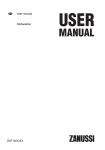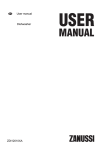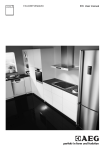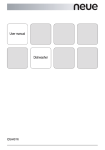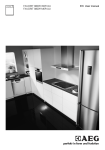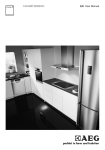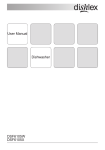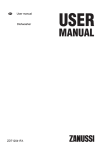Download User manual Dishwasher ZDF11001WA
Transcript
EN User manual Dishwasher ZDF11001WA Contents Safety instructions _ _ _ _ _ _ _ _ _ _ _ _ _ _ Control panel _ _ _ _ _ _ _ _ _ _ _ _ _ _ _ _ _ Programmes _ _ _ _ _ _ _ _ _ _ _ _ _ _ _ _ _ _ Options _ _ _ _ _ _ _ _ _ _ _ _ _ _ _ _ _ _ _ _ Before first use _ _ _ _ _ _ _ _ _ _ _ _ _ _ _ _ Daily use _ _ _ _ _ _ _ _ _ _ _ _ _ _ _ _ _ _ _ _ 2 3 4 5 5 6 Hints and tips _ _ _ _ _ _ _ _ _ _ _ _ _ _ _ _ _ 8 Care and cleaning _ _ _ _ _ _ _ _ _ _ _ _ _ _ _ 9 Troubleshooting _ _ _ _ _ _ _ _ _ _ _ _ _ _ _ 10 Technical information _ _ _ _ _ _ _ _ _ _ _ _ 11 Environment concerns _ _ _ _ _ _ _ _ _ _ _ _ 11 Subject to change without notice. Safety instructions Before the installation and use of the appliance, carefully read the supplied instructions. The manufacturer is not responsible if an incorrect installation and use causes injuries and damages. Always keep the instructions with the appliance for future reference. Children and vulnerable people safety Warning! Risk of suffocation, injury or permanent disability. • Do not let persons, children included, with reduced physical sensory, reduced mental functions or lack of experience and knowledge use the appliance. They must have supervision or instruction for the operation of the appliance by a person who is responsible for their safety. • Do not let children play with the appliance. • Keep all packaging away from children. • Keep all detergents away from children. • Keep children and pets away from the appliance door when it is open. Installation • Remove all the packaging. • Do not install or use a damaged appliance. • Do not install or use the appliance where the temperature is less than 0 °C. • Obey the installation instruction supplied with the appliance. Electrical connection Warning! Risk of fire and electrical shock. • Make sure that the electrical information on the rating plate agrees with the power supply. If not, contact an electrician. • Always use a correctly installed shockproof socket. • Do not use multi-plug adapters and extension cables. • Make sure not to cause damage to the mains plug and to the mains cable. Should the appliance power supply cable need to be replaced, this must be carried out by our Service Centre. • Connect the mains plug to the mains socket only at the end of the installation. Make sure that there is access to the mains plug after the installation. • Do not pull the mains cable to disconnect the appliance. Always pull the mains plug. • Do not touch the mains cable or the mains plug with wet hands. • Only for UK and Ireland. The appliance has a 13 amp mains plug. If it is necessary to change the fuse in the mains plug, use a 13 amp ASTA (BS 1362) fuse. • This appliance complies with the E.E.C. Directives. Water connection • Make sure not to cause damage to the water hoses. • The appliance is to be connected to the water mains using the new supplied hose-sets. Old hose sets must not be reused. • The appliance must be earthed. 2 www.zanussi.com • Before you connect the appliance to new pipes or pipes not used for a long time, let the water flow until it is clean. • The first time you use the appliance, make sure that there is no leakage. Use • This appliance is intended to be used in household and similar applications such as: – Staff kitchen areas in shops, offices and other working environments – Farm houses – By clients in hotels, motels and other residential type environments – Bed and breakfast type environments. Warning! Risk of injury, burns, electrical shock or fire. • Do not change the specification of this appliance. • Put knives and cutlery with sharp points in the cutlery basket with the points down or in a horizontal position. • Do not keep the appliance door open without supervision to prevent to fall on it. • Do not sit or stand on the open door. • Dishwasher detergents are dangerous. Obey the safety instructions on the detergent packaging. • Do not drink and play with the water in the appliance. • Do not remove the dishes from the appliance until the programme is completed. There can be detergent on the dishes. • The appliance can release hot steam if you open the door while a programme operates. • Do not put flammable products or items that are wet with flammable products in, near or on the appliance. • Do not use water spray and steam to clean the appliance. Disposal Warning! Risk of injury or suffocation. • Disconnect the appliance from the mains supply. • Cut off the mains cable and discard it. • Remove the door catch to prevent children and pets to get closed in the appliance. Service • Contact the Service to repair the appliance. We recommend only the use of original spare parts. • When you contact the Service, ensure that you have the following information that is available on the rating plate. Model : PNC : Serial Number : Control panel 1 6 1 On/off indicator 2 Programme marker www.zanussi.com 2 3 5 4 3 Indicators 4 Start button 3 6 Programme knob 5 Half load button Indicators Description End indicator. Salt indicator. This indicator is off while the programme operates. Rinse aid indicator. This indicator is off while the programme operates. Programmes Programme 1) 2) 3) 4) Degree of soil Type of load Programme phases Duration (min) Energy (kWh) Water (l) Normal soil Crockery and cutlery Prewash Wash 50 °C Rinses Dry 195 1.02 11 Normal soil Crockery and cutlery Prewash Wash 65 °C Rinses Dry 100 - 110 1.2 - 1.6 15 - 16 Heavy soil Crockery, cutlery, pots and pans Prewash Wash 70 °C Rinses Dry 130 - 150 1.4 13 - 15 Fresh soil Crockery and cutlery Wash 65 °C Rinse 30 0.8 9 All Prewash 14 0.1 4 1) The pressure and the temperature of the water , the variations of the mains supply, the options and the quantity of dishes can change the values. 2) With this programme you have the most efficient use of water and energy consumption for crockery and cutlery with normal soil. (This is the standard programme for test institutes). 3) With this programme you can wash a load with fresh soil. It gives good washing results in a short time. 4) Use this programme to quickly rinse the dishes. This prevents the remaining food to bond on the dishes and bad odours to come out from the appliance. Do not use detergent with this programme. Information for test institutes For all the necessary information for test performance. send an email to: [email protected] Write down the product number (PNC) that is on the rating plate. 4 www.zanussi.com Options Half-load Activate or deactivate this option before the start of a programme. You cannot activate or deactivate this option while a programme operates. Set this option when you want to wash a small quantity of tableware and cookware. This option decreases the programme duration and the consumption of energy and water. Load the upper basket and the lower basket and decrease the quantity of detergent. This option is not applicable to and . Before first use 1. Make sure that the set level of the water softener agrees with the water hardness in your area. If not, adjust the water softener. Contact your local water authority to know the water hardness in your area. 2. Fill the salt container. 3. Fill the rinse aid dispenser. 4. Open the water tap. 5. Processing residues can stay in the appliance. Start a programme to remove them. Do not use detergent and do not load the baskets. Adjusting the water softener Water softener adjustment Water hardness German degrees (°dH) French degrees (°fH) mmol/l Clarke degrees Level 47 - 50 84 - 90 8.4. - 9.0 58 - 63 10 43 - 46 76 - 83 7.6 - 8.3 53 - 57 9 37 - 42 65 - 75 6.5 - 7.5 46 - 52 8 29 - 36 51 - 64 5.1 - 6.4 36 - 45 7 23 - 28 40 - 50 4.0 - 5.0 28 - 35 6 19 - 22 33 - 39 3.3 - 3.9 23 - 27 5 1) 15 - 18 26 - 32 2.6 - 3.2 18 - 22 4 11 - 14 19 - 25 1.9 - 2.5 13 - 17 3 4 - 10 7 - 18 0.7 - 1.8 5 - 12 2 <4 <7 < 0.7 <5 12) 1) Factory position. 2) Do not use salt at this level. How to adjust the level of the water softener 1. Make sure that the programme marker on the knob is aligned with . www.zanussi.com 2. Press and hold . At the same time turn the knob counterclockwise until the pro. gramme marker is aligned with 3. Release when and start to flash. 5 4. Press . • starts to flash. • and continue to flash. Put 1 litre of water in the salt container (only for the first time). Filling the rinse aid dispenser • The intermittent flashing of refers to the current set level,, e.g. 5 flashes + pause + 5 flashes = level 5. 5. Press again and again to change the setting. Each time you press the level number increases. 6. To confirm the setting and deactivate the appliance, turn the knob until the programme marker is aligned with . 2 1 2 1 Filling the salt container 2 3 1 4 1 Caution! Water and salt can come out from the salt container when you fill it. Risk of corrosion. To prevent it, after you fill the salt container, start a programme. 2 3 4 To adjust the released quantity of rinse aid, turn the selector between position 1 (lowest quantity) and position 4 (highest quantity). 1 2 3 4 Daily use 1. Open the water tap. 2. Turn the knob until the programme marker is aligned with the programme you want to set. Set the correct programme for the type of load and the degree of soil. 6 • If the salt indicator is on, fill the salt container. • If the rinse aid indicator is on, fill the rinse aid dispenser. 3. Load the baskets. www.zanussi.com 4. Add the detergent. 5. Start the programme. 4. Adjust the water softener to the water hardness in your area. 5. Adjust the released quantity of rinse aid. Using the detergent Setting and starting a programme 1 Setting mode The appliance must be in setting mode to start a programme. Turn the programme knob until the programme marker is aligned with a programme on the control panel. If comes on and starts to flash the appliance is in setting mode. If the control panel does not show this condiand tion, press and hold, at the same time until the appliance is in setting mode 2 2 1 A 30 3 B Starting a programme 30 20 20 4 Put the detergent or the tablet in compartment (A) If the programme has a prewash phase, put a small quantity of detergent in compartment (B). Using the combi detergent tablets When you use tablets, that contain salt and rinse aid, do not fill the salt container and the rinse aid dispenser. The rinse aid indicator always comes on if the rinse aid dispenser is empty. 1. Adjust the water softener to the lowest level. 2. Set the rinse aid dispenser to the lowest position. 1. Open the water tap. 2. Close the appliance door. 3. Turn the knob until the programme marker is aligned with the symbol of the programme you want to set. • comes on. • starts to flash. 4. Press to start the programme. • and are on. Opening the door while the appliance operates If you open the door, the appliance stops. When you close the door, the appliance continues from the point of interruption. Cancelling the programme 1. Press and hold flash. and until starts to If you stop to use the combi detergent tablets, before you start to use separately detergent, rinse aid and dishwasher salt, do these steps: Make sure that there is detergent in the detergent dispenser before you start a new programme. 1. Set the water softener to the highest level. 2. Make sure that the salt container and the rinse aid dispenser are full. 3. Start the shortest programme with a rinsing phase, without detergent and without dishes. www.zanussi.com At the end of the programme comes When the programme is completed on. If you do not deactivate the appliance within 5 minutes all indicators goes off. This helps to decrease energy consumption. 7 1. To deactivate the appliance, turn the knob until the programme marker is aligned with . 2. Close the water tap. • First remove the items from the lower basket, then from the upper basket. • There can be water on the sides and on the door of the appliance. Stainless steel becomes cool more quickly than the dishes. Important • Let the dishes become cold before you remove them from the appliance. Hot dishes can be easily damaged. Hints and tips The water softener Hard water contains a high quantity of minerals that can cause damage to the appliance and bad washing results. The water softener neutralises these minerals. The dishwasher salt keeps the water softener clean and in good conditions. It is important to set the right level of the water softener. This makes sure that the water softener uses the correct quantity of dishwasher salt and water. Using salt, rinse aid and detergent • Only use salt, rinse aid and detergent for dishwasher. Other products can cause damage to the appliance. • The rinse aid helps, during the last rinsing phase, to dry the dishes without streaks and stains. • Combi detergent tablets contain detergent, rinse aid and other added agents. Be sure that these tablets are applicable to the water hardness in your area. Refer to the instructions on the packaging of the products. • Detergent tablets do not fully dissolve with short programmes. To prevent detergent residues on the tableware, we recommend that you use the tablets with long programmes. Do not use more than the correct quantity of detergent. Refer to the instructions on the detergent packaging. Loading the baskets Refer to the supplied leaflet with examples of the load of the baskets. 8 • Only use the appliance to wash items that are dishwasher-safe. • Do not put in the appliance items made of wood, horn, aluminium, pewter and copper. • Do not put in the appliance items that can absorb water (sponges, household cloths). • Remove remaining food from the items. • To remove easily remaining burned food, soak pots and pans in water before you put them in the appliance. • Put hollow items (cups, glasses and pans) with the opening down. • Make sure that cutlery and dishes do not bond together. Mix spoons with other cutlery. • Make sure that glasses do not touch other glasses. • Put the small items in the cutlery basket. • Put the light items in the upper basket. Make sure that they do not move. • Make sure that the spray arms can move freely before you start a programme. Before starting a programme Make sure that: • The filters are clean and correctly installed. • The spray arms are not clogged. • The position of the items in the baskets is correct. • The programme is applicable for the type of load and for the degree of soil. • The correct quantity of detergent is used. • There is dishwasher salt and rinse aid (unless you use combi detergent tablets). • The cap of the salt container is tight. www.zanussi.com Care and cleaning Warning! Before maintenance, deactivate the appliance and disconnect the mains plug from the mains socket. Dirty filters and clogged spray arms decrease the washing results. Make a check regularly and, if necessary, clean them. Cleaning the filters 7 To remove filters (B) and (C), turn the handle counterclockwise and remove. Pull apart filter (B) and (C). Wash the filters with water. Remove filter (A). Wash the filter with water. Before you put the filter (A) back, make sure that there are no residues of food or soil in or around the edge of the sump. Make sure that filter (A) is correctly positioned under the 2 guides (D). Assemble filters (B) and (C). Put them back in filter (A). Turn the handle clockwise until it locks. C B A 1 8 2 An incorrect position of the filters can cause bad washing results and damage to the appliance. 3 4 D 5 www.zanussi.com 6 Cleaning the spray arms Do not remove the spray arms. If the holes in the spray arms are clogged, remove remaining parts of soil with a thin pointed object. External cleaning Clean the appliance with a moist soft cloth. Only use neutral detergents. Do not use abrasive products, abrasive cleaning pads or solvents. Internal cleaning If you regularly use short duration programmes, these can leave deposits of grease and limescale inside the appliance. To prevent this, we recommend to run long duration programmes at least 2 times per month. 9 Troubleshooting The appliance does not start or it stops during operation. Before you contact the Service, refer to the information that follows for a solution to the problem. With some problems, different indicators flash continuously or intermittently at the same time to show an alarm code. Alarm code Problem • The start indicator flashes continuously. • The end indicator flashes 1 time intermittently. The appliance does not fill with water. • The start indicator flashes continuously. • The end indicator flashes 2 times intermittently. The appliance does not drain the water. • The start indicator flashes continuously. • The end indicator flashes 3 times intermittently. The anti-flood device is on. Warning! Deactivate the appliance before you do the checks. Turn the programme Problem You cannot activate the appliance. knob until the programme marker is aligned with the on/off indicator. Possible solution Make sure that the mains plug is connected to the mains socket. Make sure that there is not a damaged fuse in the fuse box. The programme does not start. Make sure that the appliance door is closed. Press the start button. The appliance does not fill with water. Make sure that the water tap is open. Make sure that the pressure of the water supply is not too low. For this information, contact your local water authority. Make sure that the water tap is not clogged. Make sure that the filter in the inlet hose is not clogged. Make sure that the inlet hose has no kinks or bends. The appliance does not drain the water. Make sure that the sink spigot is not clogged. Make sure that the drain hose has no kinks or bends. The anti-flood device is on. Close the water tap and contact the Service. After the checks are completed, turn the programme knob until the programme marker is aligned with programme that was in operation when the problem occurred. The programme continues from the point of interruption. If the problem occurs again, contact the Service. If other alarm codes show, contact the Service. 10 If the washing and drying results are not satisfactory Whitish streaks or bluish layers on glasses and dishes • The released quantity of rinse aid is too much. Adjust the rinse aid selector to a lower position. • The quantity of detergent is too much. www.zanussi.com Stains and dry water drops on glasses and dishes • The released quantity of rinse aid is not sufficient. Adjust the rinse aid selector to a higher position. • The quality of the detergent can be the cause. • The rinse aid dispenser is empty. • The quality of the rinse aid can be the cause. Refer to ‘HINTS AND TIPS’ for other possible causes. Dishes are wet • The programme is without a drying phase or with a low temperature drying phase. Technical information Dimensions Width / Height / Depth (mm) Electrical connection Refer to the rating plate. Voltage 600 / 850 / 625 220-240 V Frequency 50 Hz Water supply pressure Min. / max. (bar / MPa) (0.5 / 0.05 ) / (8 / 0.8 ) Water supply 1) Cold water or hot water2) Capacity Place settings 12 Power consumption Left-on mode 0.50 W Off-mode 0.50 W max. 60 °C 1) Connect the water inlet hose to a water tap with a 3/4'' thread. 2) If the hot water comes from alternative sources of energy, (e.g. solar panels, aeolian energy), use the hot water supply to decrease energy consumption. Rating plate Mod. ... ... ... Prod. No. ... ... ... Ser. No. ... Environment concerns Recycle the materials with the symbol . Put the packaging in applicable containers to recycle it. Help protect the environment and human health and to recycle waste of electrical and electronic appliances. Do not dispose appliances marked www.zanussi.com with the symbol with the household waste. Return the product to your local recycling facility or contact your municipal office. • Discard correctly the packaging material. Recycle the materials with the symbol . 11 156966970-A-292013 www.zanussi.com/shop













